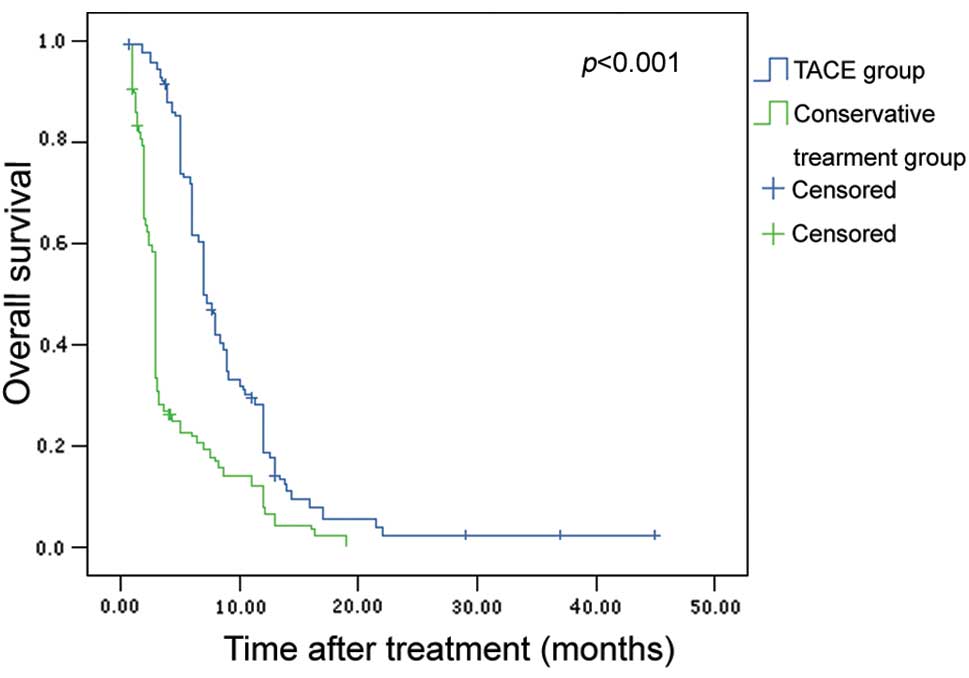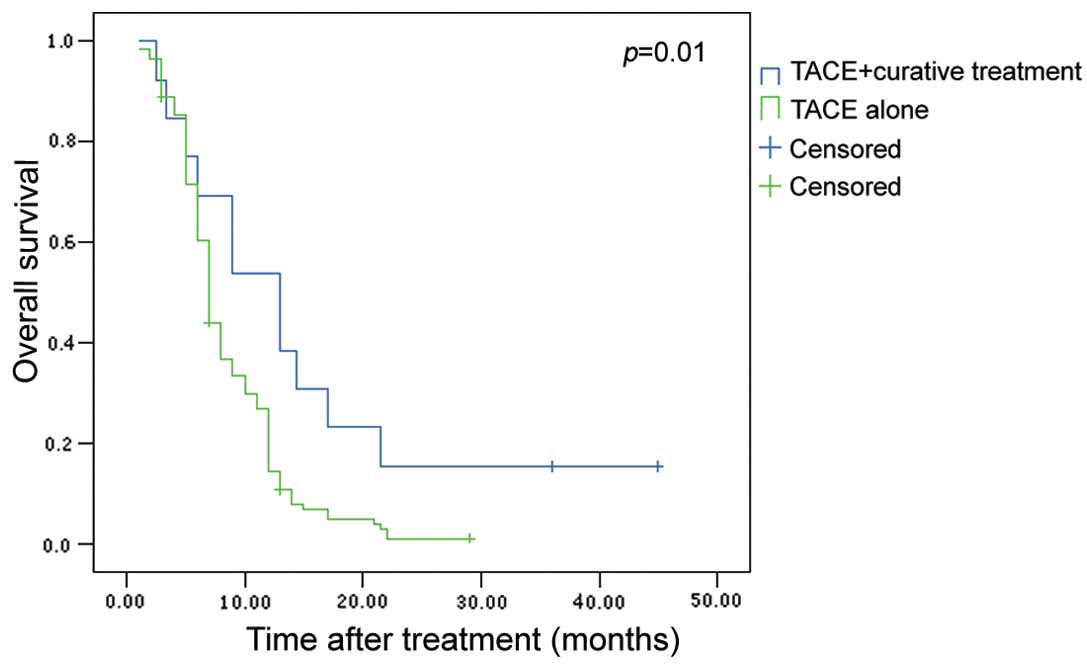|
1
|
Jemal A, Bray F, Center MM, Ferlay J, Ward
E and Forman D: Global cancer statistics. CA Cancer J Clin.
61:69–90. 2011. View Article : Google Scholar
|
|
2
|
Parkin DM, Bray F, Ferlay J and Pisani P:
Global cancer statistics, 2002. CA Cancer J Clin. 55:74–108. 2005.
View Article : Google Scholar
|
|
3
|
Llovet JM, Burroughs A and Bruix J:
Hepatocellular carcinoma. Lancet. 362:1907–1917. 2003. View Article : Google Scholar
|
|
4
|
El-Serag HB: Hepatocellular carcinoma. N
Engl J Med. 365:1118–1127. 2011. View Article : Google Scholar : PubMed/NCBI
|
|
5
|
Trevisani F, Caraceni P, Bernardi M, et
al: Gross pathologic types of hepatocellular carcinoma in Italian
patients. Relationship with demographic, environmental and clinical
factors. Cancer. 72:1557–1563. 1993. View Article : Google Scholar
|
|
6
|
Okuda K, Peters RL and Simson IW: Gross
anatomic features of hepatocellular carcinoma from three disparate
geographic areas. Proposal of new classification. Cancer.
54:2165–2173. 1984. View Article : Google Scholar : PubMed/NCBI
|
|
7
|
Lencioni R, Crocetti L, Della Pina MC and
Cioni D: Guidelines for imaging focal lesions in liver cirrhosis.
Expert Rev Gastroenterol Hepatol. 2:697–703. 2008. View Article : Google Scholar : PubMed/NCBI
|
|
8
|
Kanematsu M, Semelka RC, Leonardou P,
Mastropasqua M and Lee JK: Hepatocellular carcinoma of diffuse
type: MR imaging findings and clinical manifestations. J Magn Reson
Imaging. 18:189–195. 2003. View Article : Google Scholar : PubMed/NCBI
|
|
9
|
Demirjian A, Peng P, Geschwind JF, et al:
Infiltrating hepatocellular carcinoma: seeing the tree through the
forest. J Gastrointest Surg. 15:2089–2097. 2011. View Article : Google Scholar : PubMed/NCBI
|
|
10
|
Llovet JM, Ricci S, Mazzaferro V, et al;
SHARP Investigators Study Group. Sorafenib in advanced
hepatocellular carcinoma. N Engl J Med. 359:378–390. 2008.
View Article : Google Scholar : PubMed/NCBI
|
|
11
|
Cheng AL, Kang YK, Chen Z, et al: Efficacy
and safety of sorafenib in patients in the Asia-Pacific region with
advanced hepatocellular carcinoma: a phase III randomised,
double-blind, placebo-controlled trial. Lancet Oncol. 10:25–34.
2009. View Article : Google Scholar
|
|
12
|
Forner A, Reig ME, de Lope CR and Bruix J:
Current strategy for staging and treatment: the BCLC update and
future prospects. Semin Liver Dis. 30:61–74. 2010. View Article : Google Scholar : PubMed/NCBI
|
|
13
|
Jang ES, Yoon JH, Chung JW, et al:
Survival of infiltrative hepatocellular carcinoma patients with
preserved hepatic function after treatment with transarterial
chemoembolization. J Cancer Res Clin Oncol. 139:635–643. 2013.
View Article : Google Scholar
|
|
14
|
Kneuertz PJ, Demirjian A, Firoozmand A, et
al: Diffuse infiltrative hepatocellular carcinoma: assessment of
presentation, treatment, and outcomes. Ann Surg Oncol.
19:2897–2907. 2012. View Article : Google Scholar : PubMed/NCBI
|
|
15
|
Mehta N, Fidelman N, Sarkar M and Yao FY:
Factors associated with outcomes and response to therapy in
patients with infiltrative hepatocellular carcinoma. Clin
Gastroenterol Hepatol. 11:572–578. 2013. View Article : Google Scholar : PubMed/NCBI
|
|
16
|
Lo CM, Ngan H, Tso WK, et al: Randomized
controlled trial of transarterial lipiodol chemoembolization for
unresectable hepatocellular carcinoma. Hepatology. 35:1164–1171.
2002. View Article : Google Scholar : PubMed/NCBI
|
|
17
|
Llovet JM, Real MI, Montana X, et al:
Arterial embolisation or chemoembolisation versus symptomatic
treatment in patients with unresectable hepatocellular carcinoma: a
randomised controlled trial. Lancet. 359:1734–1739. 2002.
View Article : Google Scholar
|
|
18
|
Lopez RR Jr, Pan SH, Hoffman AL, et al:
Comparison of transarterial chemoembolization in patients with
unresectable, diffuse vs. focal hepatocellular carcinoma. Arch
Surg. 137:653–658. 2002. View Article : Google Scholar : PubMed/NCBI
|
|
19
|
Pugh RN, Murray-Lyon IM, Dawson JL,
Pietroni MC and Williams R: Transection of the oesophagus for
bleeding oesophageal varices. Br J Surg. 60:646–649. 1973.
View Article : Google Scholar : PubMed/NCBI
|
|
20
|
Myung SJ, Yoon JH, Kim KM, et al: Diffuse
infiltrative hepatocellular carcinomas in a hepatitis B-endemic
area: diagnostic and therapeutic impediments.
Hepatogastroenterology. 53:266–270. 2006.PubMed/NCBI
|
|
21
|
Shi M, Chen JA, Lin XJ, et al:
Transarterial chemoembolization as initial treatment for
unresectable hepatocellular carcinoma in southern China. World J
Gastroenterol. 16:264–269. 2010. View Article : Google Scholar : PubMed/NCBI
|
|
22
|
Lencioni R and Llovet JM: Modified RECIST
(mRECIST) assessment for hepatocellular carcinoma. Semin Liver Dis.
30:52–60. 2010. View Article : Google Scholar : PubMed/NCBI
|
|
23
|
National Cancer Institute. Common
terminology criteria for adverse events (CTCAE), version 4.0.
http://evs.nci.nih.gov/ftp1/CTCAE/CTCAE_4.03_2010-06-14_QuickReference_5x7.pdf.
Accessed June 14, 2010
|
|
24
|
Shi M, Guo RP, Lin XJ, et al: Partial
hepatectomy with wide versus narrow resection margin for solitary
hepatocellular carcinoma: a prospective randomized trial. Ann Surg.
245:36–43. 2007. View Article : Google Scholar
|
|
25
|
Chen MS, Li JQ, Zheng Y, et al: A
prospective randomized trial comparing percutaneous local ablative
therapy and partial hepatectomy for small hepatocellular carcinoma.
Ann Surg. 243:321–328. 2006. View Article : Google Scholar
|
|
26
|
Lau WY, Leung TW, Lai BS, et al:
Preoperative systemic chemoimmunotherapy and sequential resection
for unresectable hepatocellular carcinoma. Ann Surg. 233:236–241.
2001. View Article : Google Scholar : PubMed/NCBI
|
|
27
|
Lau WY, Ho SK, Yu SC, Lai EC, Liew CT and
Leung TW: Salvage surgery following downstaging of unresectable
hepatocellular carcinoma. Ann Surg. 240:299–305. 2004. View Article : Google Scholar : PubMed/NCBI
|
|
28
|
Lau WY and Lai EC: Salvage surgery
following downstaging of unresectable hepatocellular carcinoma - a
strategy to increase resectability. Ann Surg Oncol. 14:3301–3309.
2007. View Article : Google Scholar : PubMed/NCBI
|
|
29
|
Lau WY, Yu SC, Lai EC and Leung TW:
Transarterial chemoembolization for hepatocellular carcinoma. J Am
Coll Surg. 202:155–168. 2006. View Article : Google Scholar : PubMed/NCBI
|












